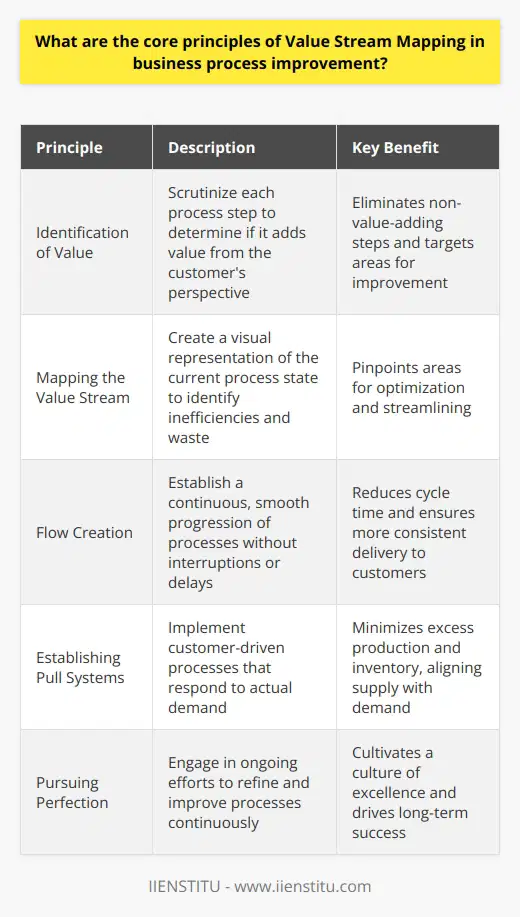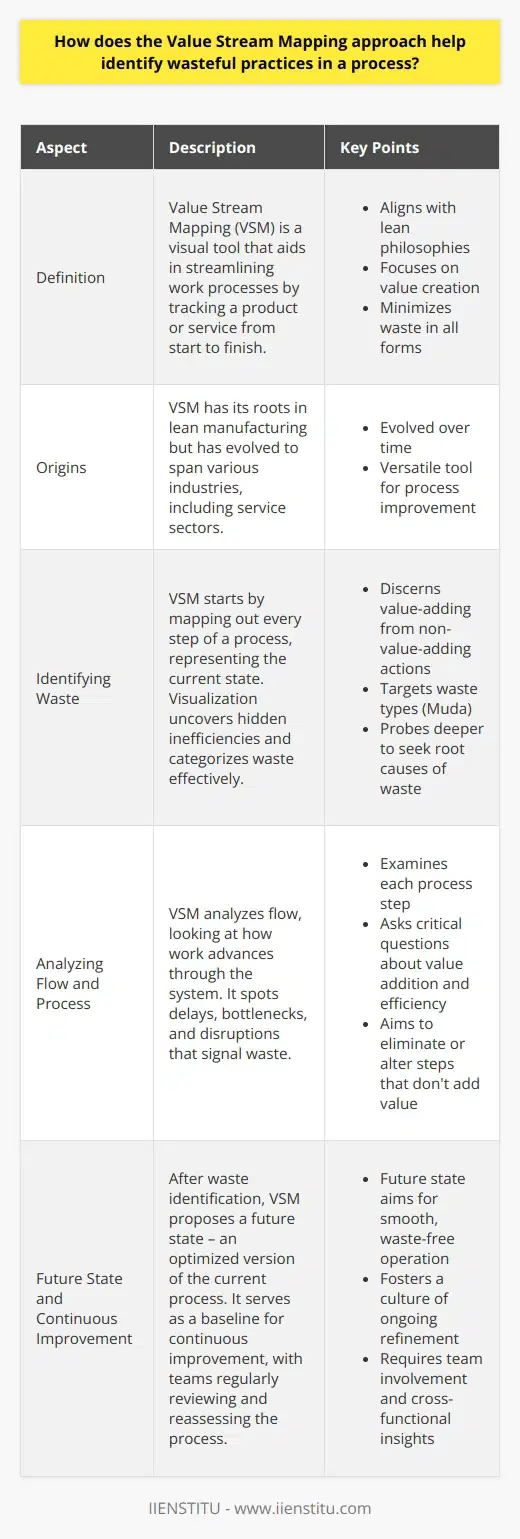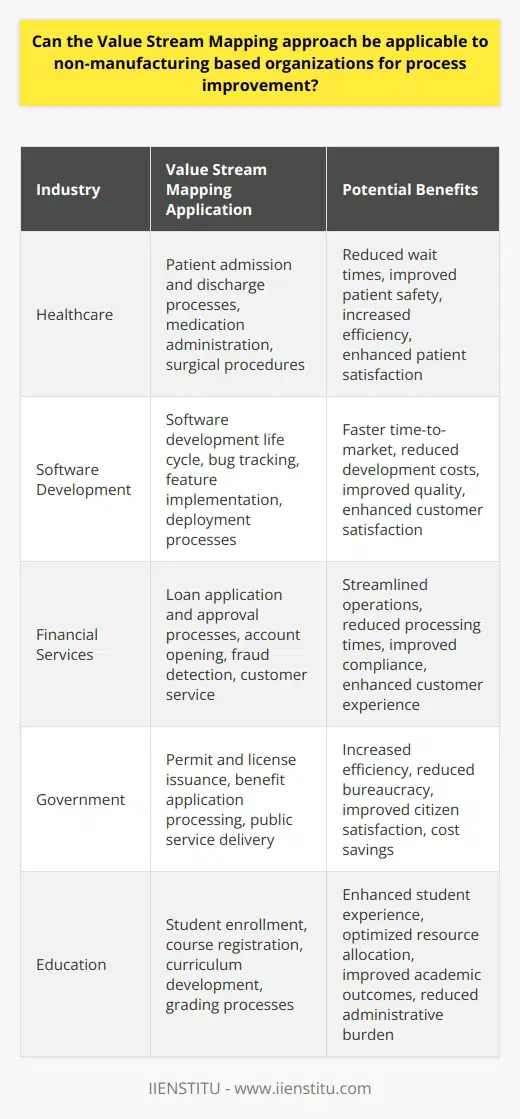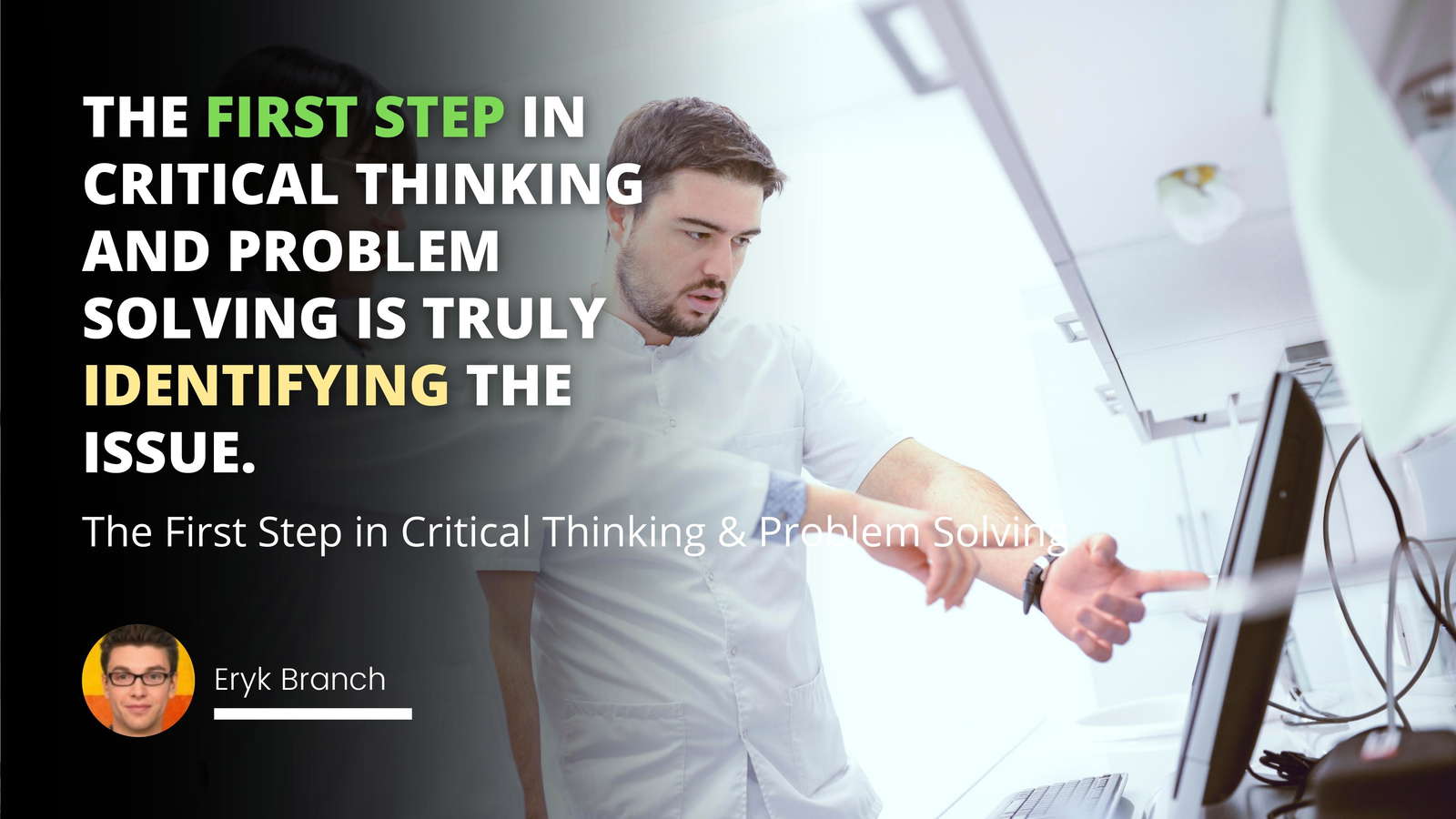
Value Stream Mapping (VSM) has emerged as a powerful tool for organizations seeking to optimize their processes, reduce waste, and enhance overall efficiency. As someone who has personally witnessed the transformative impact of VSM, I can attest to its ability to revolutionize the way businesses operate. In this blog post, we'll dive deep into the world of Value Stream Mapping, exploring its key components, the process of creating a VSM, its benefits, challenges, and real-world applications.
Understanding the Essence of Value Stream Mapping
At its core, Value Stream Mapping is a visual representation of the flow of materials and information required to deliver a product or service to the customer. It provides a comprehensive overview of the entire process, from start to finish, enabling organizations to identify areas of waste, inefficiencies, and opportunities for improvement.
The Building Blocks of a Value Stream Map
A typical Value Stream Map consists of several essential elements:
Process Steps: These are the sequential actions that transform raw materials or inputs into the final product or service. Each step is carefully mapped out, providing a clear picture of the workflow.
Material and Information Flow: VSM illustrates the movement of materials and the exchange of information between processes and departments. This helps identify bottlenecks, delays, and communication gaps.
Timeline: A crucial component of VSM is the timeline, which quantifies the time spent on each process step. It distinguishes between value-adding activities and non-value-adding activities, enabling teams to focus on eliminating waste.
Decoding the Symbols and Terminology
To effectively create and interpret a Value Stream Map, it's essential to familiarize yourself with the standard symbols and terminology used:
Symbols: VSM employs a set of universally recognized symbols to represent processes, inventory, suppliers, customers, and various types of information flow. These symbols ensure clarity and consistency across different VSMs.
Key Terms: Terms like Lead Time, Cycle Time, Work in Progress (WIP), and Takt Time are frequently used in VSM discussions. Understanding these concepts is crucial for identifying improvement opportunities and setting performance targets.
Embarking on the VSM Journey: A Step-by-Step Guide
Creating a Value Stream Map is a systematic process that involves several key stages:
Define the Scope: Begin by clearly defining the product or service that will be the focus of your VSM. This helps establish boundaries and ensures a targeted approach.
Map the Current State: Engage with cross-functional teams to map out the current state of the process. This involves gathering data, observing the workflow, and documenting each step in detail.
Identify Waste and Inefficiencies: Analyze the current state map to pinpoint areas of waste, such as overproduction, waiting times, unnecessary transportation, excess inventory, overprocessing, defects, and underutilized talent.
Envision the Future State: Based on the insights gained from the current state analysis, develop a future state map that represents an ideal workflow. This map should eliminate identified wastes and optimize the process flow.
Create an Action Plan: Develop a detailed action plan to bridge the gap between the current state and the desired future state. Assign responsibilities, set timelines, and establish metrics to track progress.
Leveraging Technology for Efficient VSM
In today's digital age, technology has greatly simplified the VSM process. Specialized software tools enable teams to create digital Value Stream Maps, facilitating real-time collaboration, data analysis, and seamless sharing across the organization. These tools enhance the accuracy, efficiency, and accessibility of the VSM process.
The Transformative Power of Value Stream Mapping
Implementing Value Stream Mapping can yield significant benefits for organizations across various industries:
Boosting Efficiency and Productivity
By identifying and eliminating waste, VSM helps organizations streamline their processes, leading to improved efficiency and productivity. Resources are better allocated to value-adding activities, resulting in faster turnaround times and increased output.
Fostering a Culture of Continuous Improvement
VSM provides a structured approach to identify areas for improvement and drive continuous optimization. It encourages teams to constantly seek ways to eliminate waste, reduce lead times, and enhance quality. This mindset of continuous improvement becomes ingrained in the organizational culture, leading to sustained growth and competitiveness.
Enhancing Communication and Collaboration
The visual nature of VSM facilitates effective communication and collaboration among cross-functional teams. It breaks down silos and promotes a shared understanding of the end-to-end process. This improved communication leads to better decision-making, faster problem-solving, and increased teamwork.
Navigating the Challenges of Value Stream Mapping
While VSM offers numerous benefits, implementing it can come with its own set of challenges:
Overcoming Resistance to Change
Introducing VSM may face resistance from individuals who are comfortable with existing processes. It's crucial to communicate the benefits of VSM clearly and involve all stakeholders in the process to build buy-in and support.
Avoiding Common Pitfalls
Misinterpreting symbols, overlooking key data, or failing to capture the true process flow can lead to inaccurate Value Stream Maps. Providing comprehensive training, seeking expert guidance, and regularly reviewing and updating the VSM can help mitigate these risks.
Real-World Success Stories: VSM in Action
Value Stream Mapping has been successfully applied across various industries, yielding impressive results:
Manufacturing: Toyota, the pioneer of Lean Manufacturing, has extensively used VSM to streamline its production processes, reduce lead times, and improve quality. Their success has inspired countless other manufacturers to adopt VSM.
Healthcare: Hospitals and clinics have employed VSM to optimize patient flow, reduce waiting times, and improve the overall patient experience. For example, Virginia Mason Medical Center used VSM to redesign their emergency department, resulting in a 50% reduction in patient wait times.
Software Development: VSM has been adapted to the world of software development, helping teams identify bottlenecks, eliminate waste, and improve the flow of value to customers. Spotify, the popular music streaming service, has successfully used VSM to optimize their development processes and deliver features faster.
Conclusion: Embracing VSM for Operational Excellence
In today's competitive business landscape, organizations must continuously strive for process improvement and operational excellence. Value Stream Mapping provides a powerful framework to achieve these goals by visualizing the flow of value, identifying waste, and driving continuous improvement.
As someone who has seen firsthand the transformative impact of VSM, I strongly encourage organizations to embrace this methodology. By investing in training, leveraging technology, and fostering a culture of continuous improvement, businesses can unlock the full potential of Value Stream Mapping and achieve significant gains in efficiency, productivity, and customer satisfaction.
Remember, the journey towards operational excellence is an ongoing process. Value Stream Mapping is not a one-time exercise but a continuous endeavor to optimize processes and deliver exceptional value to customers. By making VSM an integral part of your organization's DNA, you can set yourself on the path to sustainable growth and success.
So, let's roll up our sleeves, grab our VSM tools, and embark on this transformative journey together. The rewards of a streamlined, efficient, and customer-centric organization await us on the other side.
Frequently Asked Questions
What are the core principles of Value Stream Mapping in business process improvement?
Understanding Value Stream Mapping
Value Stream Mapping (VSM) stands as a vital tool in business process improvement. At its core, it offers a visual means to analyze and design the flow of materials and information. This method supports the identification and elimination of waste, streamlining of processes, and enhancement of value for the customer.
VSM's Core Principles
- Identification of Value
Each step in a process undergoes scrutiny. Does it add value? If a step fails to enhance a product or service from a customer's standpoint, it becomes a target for elimination or improvement.
- Mapping the Value Stream
VSM mandates mapping the current process states. This mapping pinpoints inefficiencies and non-value-adding steps, known generically as waste.
- Flow Creation
After identifying value and mapping processes, one must establish a continuous flow. Processes should progress smoothly without interruptions or delays. This efficiency reduces cycle time and ensures steadier delivery to customers.
- Establishing Pull Systems
Pull systems empower customers to drive processes. Instead of pushing products towards them, pull systems respond to actual demand, thereby reducing excess production and inventory.
- Pursuing Perfection
VSM is not a one-off exercise. It mandates ongoing efforts to refine processes. Continuous improvement cultivates a culture of excellence. Over time, it results in processes near to perfection.
Applying VSM in Practice
To apply VSM effectively, businesses must involve teams across all levels. Collaboration fosters a shared understanding of processes and engages everyone in the drive towards improvement. This collective approach ensures that mapping becomes an integrative effort, incorporating diverse perspectives and insights.
Benefits of Adhering to VSM Principles
Adherence to these VSM principles yields profound benefits. Processes become leaner, more efficient, and better aligned with customer value. Ultimately, VSM can lead to higher quality products, quicker delivery times, and increased competitiveness in the market.
VSM: A Strategic Tool for Improvement
In summary, VSM stands as a strategic tool. It equips businesses with the foresight to eliminate waste and amplify value. Embedding these core principles in a company's culture fosters a perpetual lean mindset, inevitably driving long-term success.

How does the Value Stream Mapping approach help identify wasteful practices in a process?
Value Stream Mapping: A Lens on Waste
Value Stream Mapping (VSM) stands as a visual tool. It aids in streamlining work processes. The method tracks a product or service from start to finish. The approach aligns with lean philosophies. Lean thinking focuses on value creation. It minimizes waste in all forms.
Origins of VSM
VSM has roots in lean manufacturing. It has evolved over time. Today, it spans various industries. Service sectors employ VSM too. It’s a versatile tool for process improvement.
Identifying Waste Through VSM
The approach starts with a simple task. Map out every step of a process. This represents the current state. Visualization is key here. It uncovers hidden inefficiencies. VSM discerns value-adding from non-value-adding actions. It categorizes waste effectively.
Types of Waste in VSM
Lean methodology specifies types of waste. We label them using a Japanese term, "Muda." VSM targets these waste types. Examples include:
- Overproduction
- Waiting times
- Unnecessary transport
- Excess inventory
- Overprocessing
- Motion waste
- Defects
VSM does not stop at identifying Muda. It probes deeper. It seeks the root causes of waste.
Analyzing Flow and Process
VSM analyzes flow. It looks at how work advances through the system. Blockages become apparent. The tool spots delays and bottlenecks. These disruptions signal waste.
We examine each process step. We ask critical questions. Does it add value? Could we do it more efficiently? Eliminating or altering steps that don't add value stands as the goal.
Creating a Future State
After waste identification, VSM proposes a future state. This is an optimized version of the current process. The future state aims for smooth, waste-free operation. It represents the ideal flow.
Continuous Improvement
VSM does not end with a future state design. It serves as a baseline for continuous improvement. Teams review and reassess regularly. They adapt the process to changing conditions. VSM fosters a culture of ongoing refinement.
Engaging the Whole Team
VSM requires team involvement. It’s not a solitary exercise. Cross-functional teams contribute insights. They foster a shared understanding of the processes. Team engagement promotes buy-in for changes.
Conclusion
Value Stream Mapping surfaces inefficiencies. It uncovers non-value-adding activities. VSM serves as a powerful tool for waste reduction. It propels organizations towards leaner operations. The approach underpins continuous improvement. It stresses the importance of a team-centric approach. With VSM, organizations stride towards operational excellence.

Can the Value Stream Mapping approach be applicable to non-manufacturing based organizations for process improvement?
Understanding Value Stream Mapping
Value Stream Mapping (VSM) arises from lean manufacturing. It serves as a tool for visualizing process flows. Firms use it to identify waste, delay, and inefficiencies. Its core premise is simple. One must map out all steps in a process. We can then pinpoint where improvements can happen.
VSM in Non-Manufacturing Contexts
Non-manufacturing organizations often wonder about VSM. They ask if it applies to their service-oriented processes. The answer is clear. The principles of VSM hold true across sectors. They are universal in their aim to enhance productivity.
Service sectors, healthcare, and government bodies benefit from VSM. They, too, have processes. These processes are ripe for the streamlining that VSM offers. Cross-industry applicability makes VSM a versatile tool.
Breaking Down Processes
All organizations follow processes. These may be customer interactions or backend data handling. VSM can visualize them. Service industries deal with intangible products. Yet, their processes can be as complex as manufacturing ones. Think of a bank loan approval or hospital patient flow. VSM can lay out these steps. It identifies delays and redundancies.
Identifying Non-Value-Add Activities
Waste is not only physical scrap or defective products. It includes unnecessary steps or wait times. In service processes, waste could be excess documentation. Or perhaps, approval layers that add no value. VSM helps to see these clearly. Firms aim to strip such activities away.
Enhancing Flow and Reducing Lead Times
In any sector, customers dislike delays. VSM assists in reducing lead times. It ensures that processes flow better. This is equally vital for a manufacturing line or a mortgage application process. Every industry desires efficiency. VSM provides the roadmap.
Encouraging a Culture of Continuous Improvement
Adopting VSM drives home the importance of ongoing improvement. It is not a one-time event but a continual pursuit. Non-manufacturing firms stand to gain from this culture. It demands regular reassessment of their value streams.
Case Studies and Success Stories
Several non-manufacturing entities have adopted VSM. They have reported improvements in service delivery and customer satisfaction. Hospitals have streamlined patient admissions. Software firms have improved deployment cycles. Each stands as testament to the broader relevance of VSM.
Conclusion
Value Stream Mapping extends well beyond the factory floor. It moves into office cubicles, hospital wards, and government offices. Its principles of waste reduction and process efficiency are universal. Non-manufacturing based organizations can harness VSM for significant process improvement. With discipline and commitment, they can realize the full potential of their operations. VSM transcends industry boundaries. It provides a path toward leaner, more effective organizational processes.



